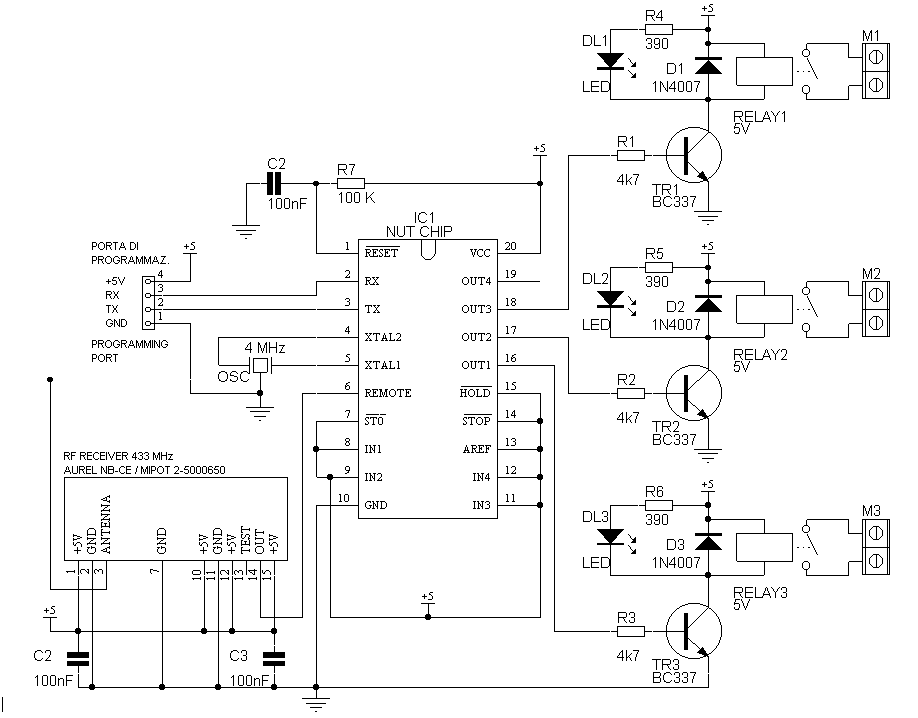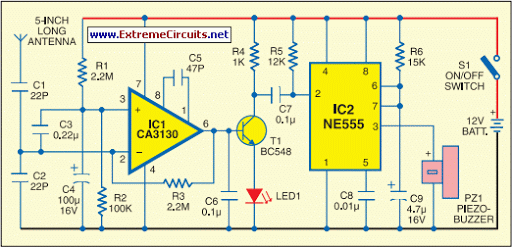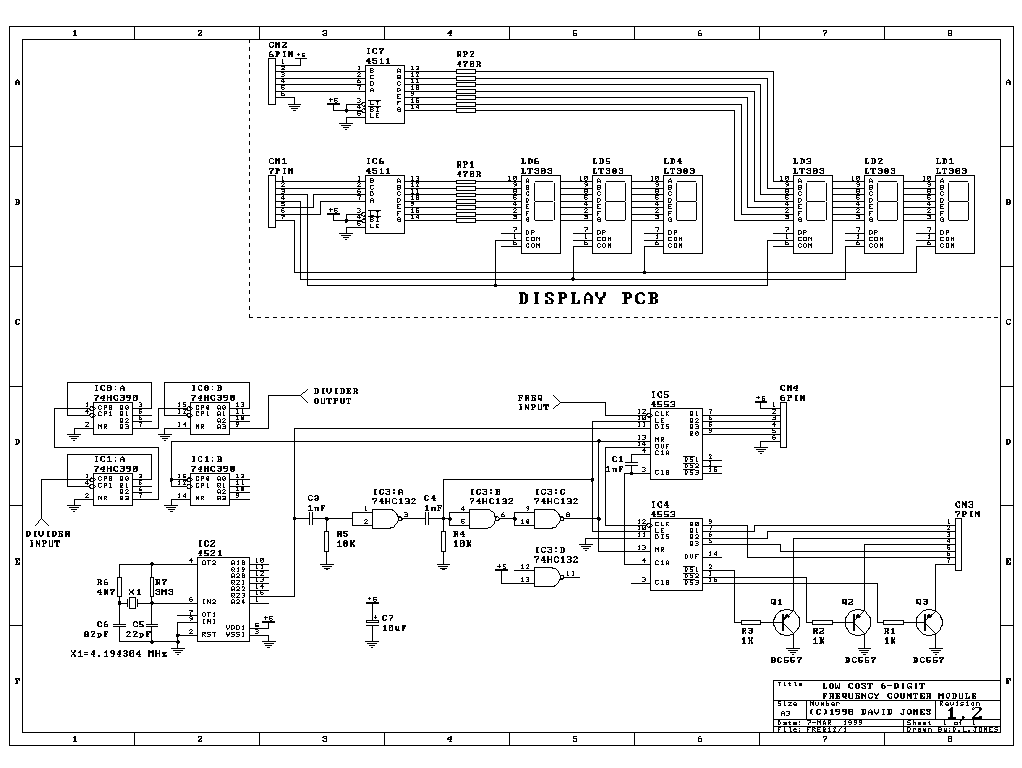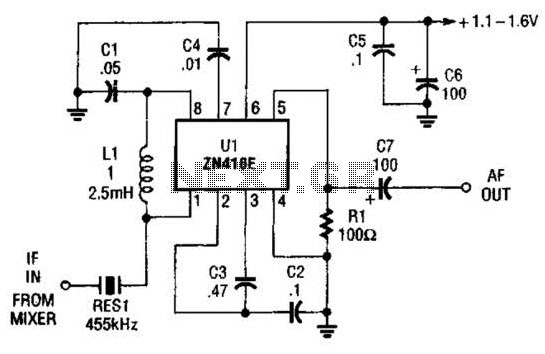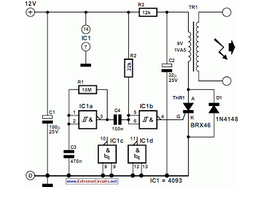
Simple 144 MHz RF Detector
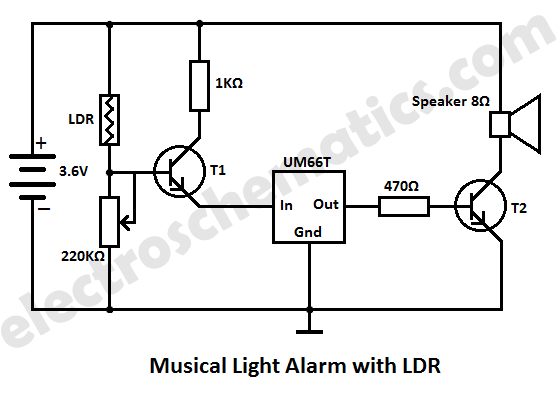
This simple circuit detects RF radiation leaking from transmitters, faulty connections, broken cables, or equipment with inadequate RF shielding. It is designed for the 2-meter amateur radio band (144-146 MHz in Europe). The instrument features a 4-step LED readout and an audible alarm for high radiation voltages. The RF signal is captured by an antenna and resonates through components C1 and L1. After rectification by diode D1, the signal is amplified using a two-transistor high-gain Darlington amplifier (T2 and T3). When all LEDs are illuminated, the optional UM66 sound/melody generator chip (IC1) is activated, providing an audible alarm. The step size and span of the instrument can be adjusted by changing the values of zener diodes D2, D4, D6, and D8. For operation in different ham or PMR bands, the resonant network (C1 and L1) can be modified. For example, a 5-watt handheld transceiver with a half-wave telescopic antenna (G = 3.5 dBd) can generate an effective radiated power (ERP) of nearly 10 watts and an electromotive force (e.m.f.) exceeding 8 volts near the operator's head. Inductor L1 is constructed with 2.5 turns of 20 SWG (approximately 1 mm diameter) enameled copper wire, with an inner diameter of about 7 mm, and it is air-cored. The accompanying trimmer capacitor C1 is adjusted to achieve the maximum number of illuminated LEDs at relatively low field strength generated by a 2-meter transceiver operating at 145 MHz.
The RF radiation detector circuit operates by utilizing a simple yet effective design that integrates various components to ensure accurate detection of unwanted RF emissions. The antenna serves as the initial point of signal acquisition, capturing the RF energy emitted from nearby sources. The resonant circuit formed by capacitor C1 and inductor L1 is critical in tuning the circuit to the desired frequency range, allowing for optimal sensitivity to signals within the 2-meter band.
The rectification process is facilitated by diode D1, which converts the alternating current (AC) RF signal into a direct current (DC) signal suitable for further amplification. The two-transistor Darlington amplifier configuration (T2 and T3) significantly increases the gain of the rectified signal, ensuring that even low levels of RF radiation can trigger the LED indicators and the alarm system.
The 4-step LED readout provides a visual representation of the detected RF radiation levels, with each LED corresponding to a specific threshold of radiation intensity. This allows users to quickly assess the RF environment. The audible alarm, activated by the UM66 chip, serves as an additional alert mechanism, providing immediate feedback when high radiation levels are detected.
The flexibility of the circuit is enhanced by the adjustable zener diodes, which allow users to customize the sensitivity and response of the instrument according to specific requirements or operational conditions. Furthermore, the ability to modify the resonant network (C1 and L1) enables the circuit to be adapted for use in other frequency bands, making it a versatile tool for amateur radio operators and RF enthusiasts.
In summary, this RF radiation detector circuit combines straightforward design principles with practical functionality, making it an essential device for monitoring RF emissions and ensuring compliance with safety standards in various electronic applications.This simple circuit helps you sniff out RF radiation leaking from your transmitter, improper joints, a broken cable or equipment with poor RF shielding. The tester is designed for the 2-m amateur radio band (144-146 MHz in Europe). The instrument has a 4-step LED readout and an audible alarm for high radiation voltages. The RF signal is picked up by an antenna and made to resonate by C1-L1. After rectifying by diode D1, the signal is fed to a two-transistor highgain Darlington amplifier, T2-T3. When all LEDs light, the (optional) UM66 sound/melody generator chip (IC1) is also actuated and supplies an audible alarm.
By changing the values of zener diodes D2, D4, D6 and D8, the step size and span of the instrument may be changed as required. For operation in other ham or PMR bands, simply change the resonant network C1-L1. As an example, a 5-watt handheld transceiver fitted with a half-wave telescopic antenna (G = 3. 5 dBd), will produce an ERP (effective radiated power) of almost 10 watts and an e. m. f. of more than 8 volts close to your head. Inductor L1 consists of 2. 5 turns of 20 SWG (approx. 1 mm dia) enamelled copper wire. The inside diameter is about 7 mm and no core is used. The associated trimmer capacitor C1 is tuned for the highest number of LEDs to light at a relatively low fieldstrength put up by a 2-m transceiver transmitting at 145 MHz.
🔗 External reference
The RF radiation detector circuit operates by utilizing a simple yet effective design that integrates various components to ensure accurate detection of unwanted RF emissions. The antenna serves as the initial point of signal acquisition, capturing the RF energy emitted from nearby sources. The resonant circuit formed by capacitor C1 and inductor L1 is critical in tuning the circuit to the desired frequency range, allowing for optimal sensitivity to signals within the 2-meter band.
The rectification process is facilitated by diode D1, which converts the alternating current (AC) RF signal into a direct current (DC) signal suitable for further amplification. The two-transistor Darlington amplifier configuration (T2 and T3) significantly increases the gain of the rectified signal, ensuring that even low levels of RF radiation can trigger the LED indicators and the alarm system.
The 4-step LED readout provides a visual representation of the detected RF radiation levels, with each LED corresponding to a specific threshold of radiation intensity. This allows users to quickly assess the RF environment. The audible alarm, activated by the UM66 chip, serves as an additional alert mechanism, providing immediate feedback when high radiation levels are detected.
The flexibility of the circuit is enhanced by the adjustable zener diodes, which allow users to customize the sensitivity and response of the instrument according to specific requirements or operational conditions. Furthermore, the ability to modify the resonant network (C1 and L1) enables the circuit to be adapted for use in other frequency bands, making it a versatile tool for amateur radio operators and RF enthusiasts.
In summary, this RF radiation detector circuit combines straightforward design principles with practical functionality, making it an essential device for monitoring RF emissions and ensuring compliance with safety standards in various electronic applications.This simple circuit helps you sniff out RF radiation leaking from your transmitter, improper joints, a broken cable or equipment with poor RF shielding. The tester is designed for the 2-m amateur radio band (144-146 MHz in Europe). The instrument has a 4-step LED readout and an audible alarm for high radiation voltages. The RF signal is picked up by an antenna and made to resonate by C1-L1. After rectifying by diode D1, the signal is fed to a two-transistor highgain Darlington amplifier, T2-T3. When all LEDs light, the (optional) UM66 sound/melody generator chip (IC1) is also actuated and supplies an audible alarm.
By changing the values of zener diodes D2, D4, D6 and D8, the step size and span of the instrument may be changed as required. For operation in other ham or PMR bands, simply change the resonant network C1-L1. As an example, a 5-watt handheld transceiver fitted with a half-wave telescopic antenna (G = 3. 5 dBd), will produce an ERP (effective radiated power) of almost 10 watts and an e. m. f. of more than 8 volts close to your head. Inductor L1 consists of 2. 5 turns of 20 SWG (approx. 1 mm dia) enamelled copper wire. The inside diameter is about 7 mm and no core is used. The associated trimmer capacitor C1 is tuned for the highest number of LEDs to light at a relatively low fieldstrength put up by a 2-m transceiver transmitting at 145 MHz.
🔗 External reference

